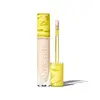What's inside
What's inside
 Key Ingredients
Key Ingredients

 Benefits
Benefits

 Concerns
Concerns

 Ingredients Side-by-side
Ingredients Side-by-side

Coco-Caprylate/Caprate
EmollientTriethylhexanoin
MaskingHydrogenated Castor Oil Isostearate
Skin ConditioningPolyglyceryl-2 Triisostearate
EmulsifyingJojoba Esters
EmollientGlyceryl Behenate
EmollientHydrogenated Polycyclopentadiene
Caprylic/Capric Triglyceride
MaskingSilica
AbrasiveBoron Nitride
AbsorbentHelianthus Annuus Seed Wax
Skin ConditioningHelianthus Annuus Seed Oil
EmollientHydrogenated Sunflower Seed Oil
Skin ConditioningSorbitan Sesquiisostearate
EmulsifyingTrihydroxystearin
Skin ConditioningIsopropyl Titanium Triisostearate
EmollientEthylhexylglycerin
Skin ConditioningMica
Cosmetic ColorantAcacia Decurrens Flower Wax
EmollientPolyglycerin-3
HumectantCamellia Sinensis Seed Oil
HumectantPunica Granatum Seed Oil
EmollientOlea Europaea Fruit Oil
MaskingRicinus Communis Seed Oil
MaskingTocopherol
AntioxidantCalendula Officinalis Flower Extract
MaskingCI 77891
Cosmetic ColorantIron Oxides
CI 77492
Cosmetic ColorantCI 77499
Cosmetic ColorantCoco-Caprylate/Caprate, Triethylhexanoin, Hydrogenated Castor Oil Isostearate, Polyglyceryl-2 Triisostearate, Jojoba Esters, Glyceryl Behenate, Hydrogenated Polycyclopentadiene, Caprylic/Capric Triglyceride, Silica, Boron Nitride, Helianthus Annuus Seed Wax, Helianthus Annuus Seed Oil, Hydrogenated Sunflower Seed Oil, Sorbitan Sesquiisostearate, Trihydroxystearin, Isopropyl Titanium Triisostearate, Ethylhexylglycerin, Mica, Acacia Decurrens Flower Wax, Polyglycerin-3, Camellia Sinensis Seed Oil, Punica Granatum Seed Oil, Olea Europaea Fruit Oil, Ricinus Communis Seed Oil, Tocopherol, Calendula Officinalis Flower Extract, CI 77891, Iron Oxides, CI 77492, CI 77499
Water
Skin ConditioningCaprylic/Capric Triglyceride
MaskingMica
Cosmetic ColorantOctyldodecanol
EmollientPolyglyceryl-2 Dipolyhydroxystearate
Skin ConditioningEthylhexyl Olivate
Skin ConditioningUndecane
EmollientGlycerin
HumectantPolyhydroxystearic Acid
EmulsifyingTridecane
PerfumingPolyglyceryl-3 Diisostearate
EmulsifyingGalactoarabinan
Helianthus Annuus Seed Wax
Skin ConditioningArnica Montana Flower Extract
MaskingCaffeine
Skin ConditioningDunaliella Salina Extract
Skin ConditioningFoeniculum Vulgare Oil
EmollientGlyceryl Oleate
EmollientHelianthus Annuus Seed Oil
EmollientLecithin
EmollientMaltodextrin
AbsorbentPalmitoyl Tripeptide-5
Skin ConditioningPanthenol
Skin ConditioningRosmarinus Officinalis Extract
AntimicrobialSodium Hyaluronate
HumectantSqualane
EmollientTocopherol
AntioxidantPotassium Sorbate
PreservativeSodium Benzoate
MaskingWater, Caprylic/Capric Triglyceride, Mica, Octyldodecanol, Polyglyceryl-2 Dipolyhydroxystearate, Ethylhexyl Olivate, Undecane, Glycerin, Polyhydroxystearic Acid, Tridecane, Polyglyceryl-3 Diisostearate, Galactoarabinan, Helianthus Annuus Seed Wax, Arnica Montana Flower Extract, Caffeine, Dunaliella Salina Extract, Foeniculum Vulgare Oil, Glyceryl Oleate, Helianthus Annuus Seed Oil, Lecithin, Maltodextrin, Palmitoyl Tripeptide-5, Panthenol, Rosmarinus Officinalis Extract, Sodium Hyaluronate, Squalane, Tocopherol, Potassium Sorbate, Sodium Benzoate
 Reviews
Reviews

Alternatives
Ingredients Explained
These ingredients are found in both products.
Ingredients higher up in an ingredient list are typically present in a larger amount.
This ingredient is an emollient, solvent, and texture enhancer. It is considered a skin-softener by helping the skin prevent moisture loss.
It helps thicken a product's formula and makes it easier to spread by dissolving clumping compounds.
Caprylic Triglyceride is made by combining glycerin with coconut oil, forming a clear liquid.
While there is an assumption Caprylic Triglyceride can clog pores due to it being derived from coconut oil, there is no research supporting this.
Learn more about Caprylic/Capric TriglycerideHelianthus Annuus Seed Oil is the oil derived from the seeds of a Sunflower. Sunflower seed oil is non-fragrant. It is an emollient, meaning it helps to soften the skin.
Sunflower seed oil contains many fatty acids. The fatty acids found in sunflower seeds include (from highest amount to least): linoleic acid, myristic acid, palmitic acid, stearic acid, arachidic acid, oleic acid, and linolenic acid.
These fatty acids help the skin create ceramides. Ceramides play a role in repairing the skin barrier.
Helianthus Annuus Seed Oil helps moisturize the skin. This in turn helps the skin look more rejuvenated and smoother.
Sunflowers are rich in vitamin E.
Historians believe Indigenous cultures of North America domesticated sunflowers before corn. Thus they relied on sunflower oil for a variety of uses. One such use is moisturizing skin and hair.
Sunflower seed oil may not be fungal acne safe. We recommend speaking with a professional if you have any concerns.
Learn more about Helianthus Annuus Seed OilHelianthus Annuus Seed Wax is created from the common sunflower.
Sunflower seed wax is made up of long chain non-glyceride esters, a small amount of fatty alcohols, and fatty acids.
This ingredient is often used to enhance the texture of products. The fatty acid properties also help hydrate the skin.
Learn more about Helianthus Annuus Seed WaxMica is a naturally occurring mineral used to add shimmer and color in cosmetics. It can also help improve the texture of a product or give it an opaque, white/silver color.
Serecite is the name for very fine but ragged grains of mica.
This ingredient is often coated with metal oxides like titanium dioxide. Trace amounts of heavy metals may be found in mica, but these metals are not harmful in our personal products.
Mica has been used since prehistoric times throughout the world. Ancient Egyptian, Indian, Greek, Roman, Aztec, and Chinese civilizations have used mica.
Learn more about MicaTocopherol (also known as Vitamin E) is a common antioxidant used to help protect the skin from free-radicals and strengthen the skin barrier. It's also fat soluble - this means our skin is great at absorbing it.
Vitamin E also helps keep your natural skin lipids healthy. Your lipid skin barrier naturally consists of lipids, ceramides, and fatty acids. Vitamin E offers extra protection for your skin’s lipid barrier, keeping your skin healthy and nourished.
Another benefit is a bit of UV protection. Vitamin E helps reduce the damage caused by UVB rays. (It should not replace your sunscreen). Combining it with Vitamin C can decrease sunburned cells and hyperpigmentation after UV exposure.
You might have noticed Vitamin E + C often paired together. This is because it is great at stabilizing Vitamin C. Using the two together helps increase the effectiveness of both ingredients.
There are often claims that Vitamin E can reduce/prevent scarring, but these claims haven't been confirmed by scientific research.
Learn more about Tocopherol